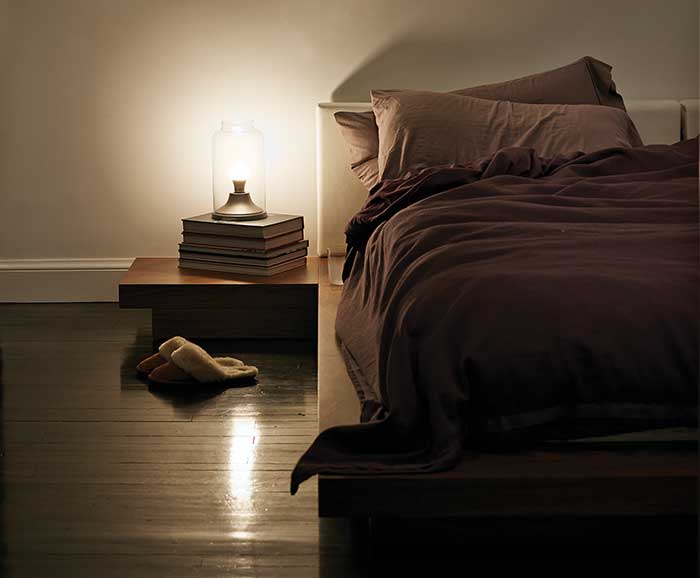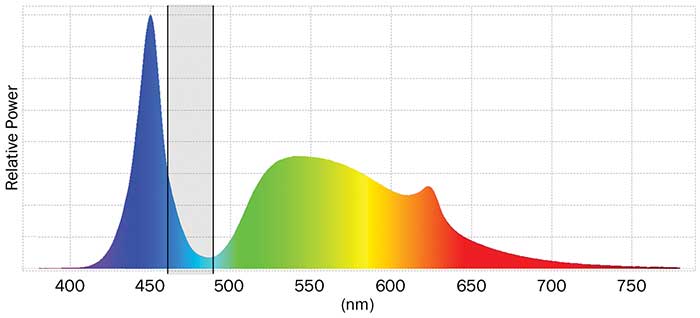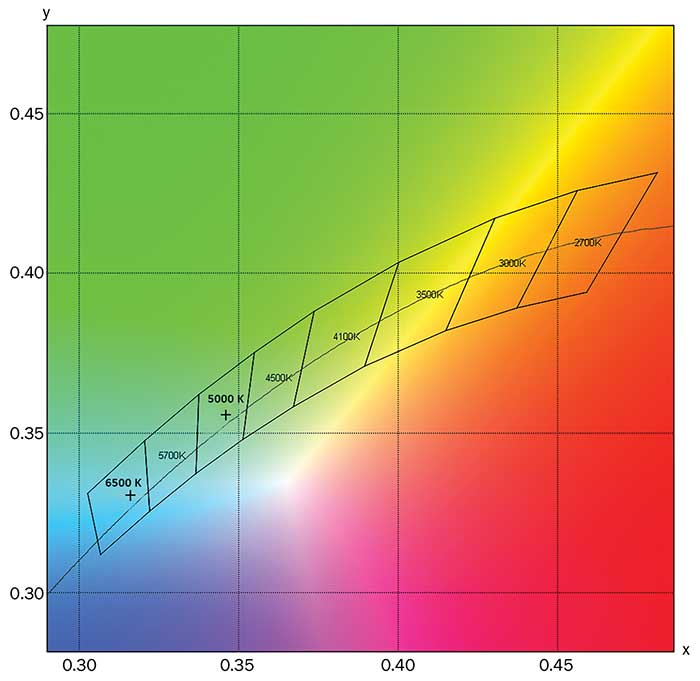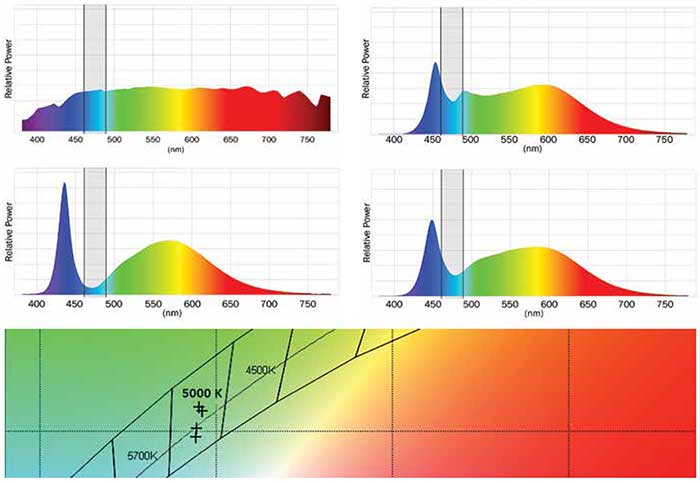Advances in precisely tunable, solid-state lighting, wearable physiological sensors have opened new possibilities for highly sophisticated and intelligent lighting control systems.
UTE BESENECKER, LIGHTING SCIENCE, AND KEN APPLEMAN
There is a lot of interest these days in the physiological effect of light on the human body. Variously referred to as human-centric lighting, biological lighting, or circadian lighting, all reflect the emerging understanding that light can have a profound effect not just on what we see around us but also upon our health. Light affects the daily rhythms of the body, including the sleep-wake cycle1; and it can impact obesity, energy and awareness2, depression, and even, among patients with various forms of dementia, agitation levels3.

Precision lighting provides the optimal sleeping conditions for the body’s circadian rhythm. Courtesy of Kendall Mills.
This understanding has led to the desire to recreate lighting conditions conducive to health. Numerous manufacturers are producing lights that they claim are tuned to produce one health effect or another. And while in some cases the manufacturers have, in fact, produced such lights, in other cases the lights fall short of their claimed effect. Furthermore, the impact of even the most precisely tuned light will vary depending upon the physiological state of the person. The right light at the wrong time can have the opposite of its desired effect.
Circadian-effective lighting
Much of the research in this very active area focuses on the impact of light on our body clocks — the internal clocks that, when functioning correctly, keep us in tune with the local natural day. The normal near-to-24-hour rhythm of our body clocks is referred to as our circadian rhythm. Lighting with wavelengths below 500 nm impacts the circadian rhythm of humans. Photoreceptors in the periphery of the eyes that signal to the parts of the brain involved in biological impact, have their peak sensitivity around 480 nm. Furthermore, short-wavelength light around 460 to 490 nm can suppress the level of melatonin in the blood4,5,6. Melatonin is a hormone with levels that change in synchronization with the circadian rhythm, and thus is used as a marker of circadian state7.

Figure 1. White LED Spectrum 1: A CCT of 5000 K that has increased energy between 460 and 490 nm (scaled for equal illuminance to Spectrum 2 in Figure 2, commercially available). Courtesy of Lighting Science Group Corporation.
While most individuals in a particular region living a normal, daytime-centered lifestyle will have their circadian rhythm synchronized to the natural day, all individual’s clocks are set differently. It isn’t possible to know the setting of someone’s clock without obtaining some physiological information about that person. The setting of someone’s circadian clock can be determined by, among other things, monitoring their melatonin levels (the level will be highest during their circadian night, and will be lowest during their circadian day), or by monitoring records of their physical activity (physical activity will tend to occur in synchronization with their circadian rhythm, with peak activity centered around their circadian daytime)8.

Figure 2. White LED Spectrum 2: A CCT of 6500 K that has relatively little energy between 460 and 490 nm, less than Spectrum 1 (5000 K) at equal illuminance levels (scaled for equal illuminance to Spectrum 1 in Figure 1, commercially available). Courtesy of Lighting Science Group Corporation.
LED products that claim to have a circadian impact are frequently described in terms of their correlated color temperature, or CCT, measured in units referred to as Kelvin (K), and ranging from about 2400 K, warm shades, to about 6500 K, cool shades. In an attempt to simplify identification of the physiological impact of a given light source, consumer information describes light with high CCT cool shades as providing a circadian benefit during an individual’s circadian morning and early part of their circadian day, and light with low CCT warm shades as providing a circadian benefit during an individual’s circadian evening. The association of CCT with a circadian effect is due to the assumption that bluer cool shades actually contain more light in the important 460- to 490-nm range than redder warm shades.
However, the CCT rating of a light source is misleading for this purpose. Light with a lower CCT (Figures 1 and 3) can actually have more energy in the 460- to 490-nm range than light with a higher CCT (Figures 2 and 3). A number of manufacturers of biological active lighting are currently taking advantage of this fact, designing white lights in neutral white CCT ranges that contain sufficient energy in the 460- to 490-nm range so they have a significant circadian impact, or, conversely, neutral white CCT ranges that have minimal circadian impact.

Figure 3. Chromaticity coordinate locations of LED Spectra 1 and 2 (indicated by crosses) with CCT binning information. Courtesy of Lighting Science Group Corporation.
It is important to understand that simply observing the appearance of a light source is insufficient. Appearance alone does not provide enough information about the spectral makeup of a light source, and thus about its physiological impact. White light comprises energy at many different wavelengths; the eye alone cannot discern the spectral composition of white light. While current lighting practice relies heavily on communicating the color appearance of a light source using its CCT or chromaticity coordinates, these metrics give some information about the visual appearance of the light source, but give no information about its biological impact (Figure 4).

Figure 4. Different spectra for a CCT of 5000 K with very different energy between 460 and 490 nm (scaled for equal illuminance). Courtesy of Lighting Science Group Corporation.
Metrics and physiology
However, several metrics make the understanding of the circadian effect of a light much clearer, and characterize the impact of light on the nonvisual system. These metrics include: equivalent melanopic lux (EML)9; the melanopic-photopic ratio (M/P)9; melatonin suppression (MS)4,5,6; circadian stimulus (CS)10; and circadian light (CL)10. Each of these metrics utilizes a somewhat different methodology to quantify and estimate the physiological impact of different lighting; some refer to the eyes’ physiology and photoreceptor sensitivity, others to experimental data for hormonal changes in response to the light, others to a combination of both.
These quantification metrics aim to provide clear information about the physiological impact of a given light source. However, these metrics are still something of a work in progress. An added challenge is presented by the fact that monochromatic light seems to follow a slightly different logic than when that same light is mixed with different wavelengths into a polychromatic, or broadband, source. Metrics are currently being discussed and decided upon by dedicated panels of scientists from different institutions and countries.
In the meantime, short of the emergence of an industry-accepted new metric, any of the metrics provide more valid information than CCT. A popular one is the M/P ratio, which is a value that can be easily calculated. It can be used to compare the capability of a light source to produce a higher nonvisual effect, such as circadian entrainment and alertness, than a comparison light source at the same light level. A higher M/P ratio value will produce a higher biological effect, and, when deciding on the most appropriate lighting for general long-term applications, it could provide adequate information. However, dosage (amount of light entering the eye) and timing are crucial.
Timing, controls and sensors
Identifying the circadian impact of a light source, however, is only one aspect of designing a lighting installation that produces an overall circadian benefit. The delivery of circadian-effective light is not necessarily a healthy choice; however, neither is the avoidance of delivering circadian-effective light. Each can be correct — and healthy — at the proper time, and can be incorrect — and unhealthy — at the improper time.
The common problem with conventional indoor lighting during the morning and daytime is that it typically does not provide enough energy between 460 to 490 nm to sufficiently support human physiology; however, for evening and nighttime use it has too much of that energy. Customized spectra can provide important solutions that support physiology and health throughout the day in today’s indoor-centric lifestyle.
When an individual who is currently in their physiological nighttime state is exposed to circadian-effective light, this light will cause the individual to be forced into a daytime state, altering hormone levels, alertness levels, sleepiness, reaction time, etc. — all of which could be desirable in some circumstances, but would be anathema to one who is attempting, for example, to maintain a healthy sleep cycle.
This means that a lighting system that is intended to provide beneficial biologically active lighting needs to have access to information about those being illuminated that has not historically been available. Prior to the possibility of customizing the circadian impact of a lighting system, it was only necessary to know about the visual and aesthetic requirements of the individuals in a space. With the advent of circadian lighting, it becomes necessary to know their physiological state — in terms of the setting of their internal clocks — along with the desired long-term or acute biological impact.
In many cases, this information can be derived from the local, natural day (adjusted for seasonal variation). In a lighting system being utilized for a standard, daily occupied space, and in which the majority of the occupants stick to a diurnally centered personal schedule — awake during the daytime and asleep at night — it is reasonable to assume that the majority of their internal clocks are synched with the natural day. However, in more complex environments, such as health care facilities or 24/7 industrial sites, the problem becomes more complex.
In order to be certain that the individual occupants of such spaces are receiving the lighting at home and work that benefits their wellbeing, the lighting system should ideally have access to information about the individuals’ sleep schedule, activity patterns, and perhaps even information about the light that they’ve been exposed to during other times of the day. In addition, the lighting system must have access to controls and intelligence that allows it to dynamically change the lighting being delivered from circadian-effective to noncircadian-effective, depending upon the information gathered from the individuals being illuminated, and the desired circadian impact of the light.
Fortunately, all this is now possible. But it is not yet fully implemented, except in experimental installations. Wearable fitness sensors now routinely gather and record information about the wearer’s activity and sleep schedules. Some wearable sensors record light exposure. At least one device purports to measure activity, heart rate and blue light exposure, all in one watch-like unit. Meanwhile, lighting control systems are constantly increasing in versatility and intelligence, and researchers are working on developing the necessary algorithms.
The problem that remains, for these environments, is integration. There is not yet good — or, for much of this, any — integration between the many parts of a system such as this. This is a result of several factors, including the plethora of lighting control options, the proprietary ownership that manufacturers of fitness trackers feel they have over their customer’s personal data, and the lack of sufficient market pressure to change any of this. To truly allow a fully circadian-aware lighting system to be created, these barriers would need to be removed, or at least become more permeable.
Keep in mind, though, that even when all of the pieces are in place, the lighting practitioner deploying this system will have to ascertain, from an examination of the use patterns and purposes of the space being illuminated, the desired outcome of any biologically active lighting system to be used. It isn’t simply the case that the lighting system should produce the appropriate lighting condition to correspond to the local day. There are circumstances where circadian-effective lighting may be appropriate even if it is the circadian nighttime of those individuals being illuminated. At a 24/7 workplace, such as a hospital or industrial facility, performance and alertness are crucial and human error can have fatal consequences.
The study of the physiological effects of light is a reasonably new science and is an even newer design practice. An understanding of these effects can have very significant results in fostering daytime health, sleep health, and productivity. Customizing lighting systems to leverage these new understandings is, itself, a new possibility: Only with the advent of precisely tunable solid-state lighting, body-wearable physiological sensors, and highly sophisticated and intelligent lighting control systems are these customizations even possible. Much work is still to be done, and increasing collaboration is called for between researchers and practitioners in the fields of lighting (engineering and design) and medicine/health care to implement solutions into the built environment. But with the rapid advancements occurring in all aspects of this topic, a future of dynamic, responsive and healthful lighting is inevitable for us all.
Meet the authors
Ute Besenecker, Ph.D., is senior scientist at Lighting Science Group and has over 20 years of experience in architecture, lighting and human factors research; email: [email protected]
Ken Appleman, Ph.D., has spent more than 30 years in the development of online, internet, light, and energy-efficiency technologies; email: [email protected].
References
1. M. Figueiro (2013). An overview of the effects of light on human circadian rhythms: Implications for new light sources and lighting systems design. J Light & Vis Env, Vol. 37, Issues 2 & 3, pp. 51-61.
2. S. Lockley et al. (2006). Short-wavelength sensitivity for the direct effects of light on alertness, vigilance, and the waking electroencephalogram in humans. Sleep, Vol. 29, pp. 161-168.
3. M. Figueiro et al. (2002). Effects of Light Exposure on Behavior of Alzheimer’s Patients – A Pilot Study. Light and Human Health: EPRI/LRO 5th International Lighting Research Symposium, pp. 151-156.
4. K. Thapan et al. (2001). An action spectrum for melatonin suppression: Evidence for a novel non-rod, non-cone photoreceptor system in humans, J Physiol, Vol. 535, Issue 1, pp. 261-267.
5. G. Brainard et al. (2001). Action spectrum for melatonin regulation in humans: evidence for a novel circadian photoreceptor.
J Neurosci, Vol. 21, Issue 16, 6405-6412.
6. D. Gall. (2004). Die Messung circadianer Strahlungsgrößen. Licht und Gesundheit, pp. 114-132.
7. S. Khalsa et al. (2003). A phase response curve to single bright light pulses in human subjects, J Physiol, Vol. 549, Issue 3,
pp. 945-952.
8. S. Ancoli-Israel et al. (2003). The role of actigraphy in the study of sleep and circadian rhythms. Sleep, Vol. 26, Issue 3, pp. 342-92.
9. R. Lucas et al. (2013). Measuring and using light in the melanopsin age. Trends Neurosci, Vol. 37, Issue 1, pp. 1-9.
10. Rea et al. (2010). Circadian light. J Circadian Rhythms, Vol. 8, Issue 2, pp. 1-10.